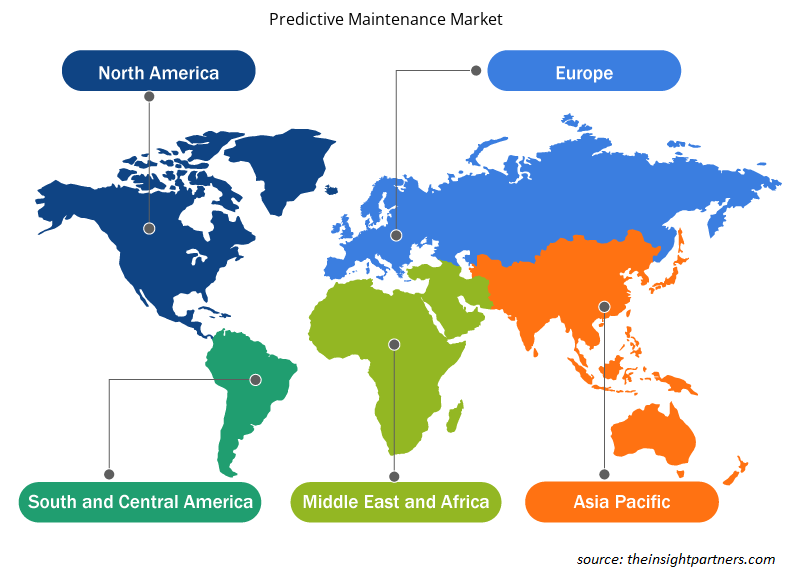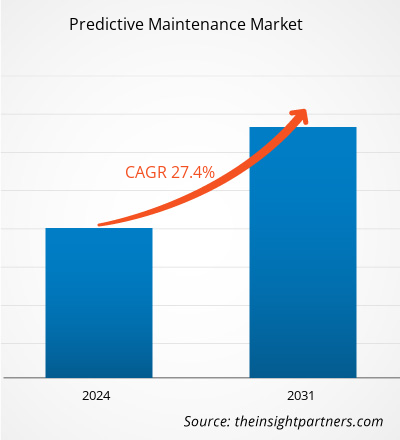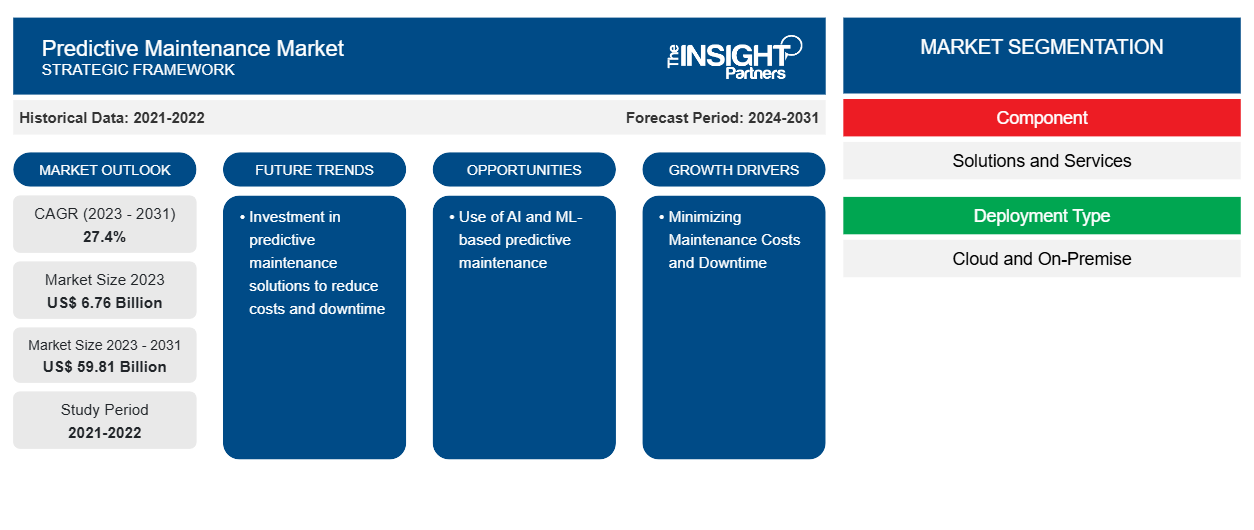Der Markt für vorausschauende Wartung soll von 6,76 Milliarden US-Dollar im Jahr 2023 auf 59,81 Milliarden US-Dollar im Jahr 2031 anwachsen. Für den Zeitraum 2023–2031 wird ein durchschnittliches jährliches Wachstum von 27,4 % erwartet. Die Investition in Lösungen für vorausschauende Wartung zur Reduzierung von Kosten und Ausfallzeiten dürfte ein wichtiger Trend auf dem Markt bleiben.CAGR of 27.4% during 2023–2031. The investment in predictive maintenance solutions to reduce costs and downtime is likely to remain a key trend in the market.
Marktanalyse für vorausschauende Wartung
In den letzten Jahrzehnten haben die hohen Forderungen nach einer Senkung der immer teurer werdenden Energiekosten und einem Übergang in eine nachhaltige Zukunft Energieaudits an Bedeutung gewonnen. Da die Energieausgaben für die Industrie ein großes Problem darstellen, überprüfen Unternehmen ihren Energieverbrauch kontinuierlich und streben danach, ihn deutlich zu minimieren.
Marktübersicht für vorausschauende Wartung
Die vorausschauende Wartung verbessert die Leistung von Anlagen durch die Kombination von Sensoren des Internets der Dinge, künstlicher Intelligenz und Datenwissenschaft. Dabei wird Cloud-basierte Technologie eingesetzt, um den Wartungsbedarf basierend auf dem Anlagenzustand zu überwachen und abzuschätzen sowie Anomalien zu identifizieren, die zu unerwarteten Ausfällen führen könnten. Hersteller profitieren daher erheblich von der Prognose des Wartungsbedarfs ihrer Anlagen, um Kosten zu sparen und die Betriebszeit zu erhöhen. Der zentrale Ansatz zur Echtzeitüberwachung von Industrieanlagen ist die zustandsbasierte Überwachung. Fortschrittliche IIoT-Sensoren zeichnen komplizierte Maschinenzustandsdaten auf, beispielsweise Vibration, Akustik, Temperatur und Drehzahl. Die gesammelten Daten werden dann ausgewertet, um Abweichungen in der Anlagenleistung oder Probleme zu identifizieren, die mit herkömmlichen Geräten nur schwer zu erkennen wären.
Passen Sie diesen Bericht Ihren Anforderungen an
Sie erhalten kostenlos individuelle Anpassungen an jedem Bericht, einschließlich Teilen dieses Berichts oder einer Analyse auf Länderebene, eines Excel-Datenpakets sowie tolle Angebote und Rabatte für Start-ups und Universitäten.
- Holen Sie sich die wichtigsten Markttrends aus diesem Bericht.Dieses KOSTENLOSE Beispiel umfasst eine Datenanalyse von Markttrends bis hin zu Schätzungen und Prognosen.
Treiber und Chancen des Marktes für vorausschauende Wartung
Minimierung von Wartungskosten und Ausfallzeiten zugunsten des Marktes
Unternehmen sind heute zunehmend bestrebt, Wartungskosten, Geräteausfälle und Ausfallzeiten zu reduzieren. Die vorausschauende Wartung ist eine hervorragende Methode, um diese Schwierigkeiten anzugehen. Systeme zur vorausschauenden Wartung nutzen Datenanalyse und maschinelles Lernen, um mögliche Gerätefehler zu erkennen, bevor sie auftreten, und ermöglichen so proaktive Wartungseingriffe. Durch die frühzeitige Vorhersage von Geräteausfällen können Unternehmen Reparaturen während geplanter Ausfallzeiten veranlassen, Betriebsunterbrechungen reduzieren und die Geräteverfügbarkeit maximieren.downtimes. Predictive maintenance is an excellent method for addressing these difficulties. Predictive maintenance systems use uptime.
Einsatz von KI- und ML-basierter vorausschauender Wartung
Die KI-basierte vorausschauende Wartung hat in der Fertigung ein breites Anwendungsspektrum. Sie nutzt leistungsstarke Algorithmen des maschinellen Lernens, um riesige Mengen an während der Produktion gesammelten Daten auszuwerten und so wichtige Erkenntnisse für die Erzielung hervorragender Fertigungsqualität zu gewinnen. Darüber hinaus nutzen Algorithmen des maschinellen Lernens riesige Mengen an historischen Daten, um verschiedene Situationen zu simulieren und vorherzusagen, was wann schiefgehen wird. Fortschrittliche Algorithmen der künstlichen Intelligenz erkennen das typische Datenverhalten einer Maschine und verwenden es als Grundlage, um Abweichungen in Echtzeit zu erkennen und vor ihnen zu warnen.
Segmentierungsanalyse des Marktberichts zur vorausschauenden Wartung
Wichtige Segmente, die zur Ableitung der Marktanalyse für vorausschauende Wartung beigetragen haben, sind Komponente, Bereitstellungstyp, Technik und Branche.
- Basierend auf den Komponenten ist der Markt nach Lösungen und Diensten segmentiert. Das Segment Lösungen hatte im Jahr 2023 einen bedeutenden Marktanteil.
- Basierend auf dem Bereitstellungstyp ist der Markt in Cloud und On-Premises segmentiert. Das Cloud-Segment hielt im Jahr 2023 den größten Marktanteil.
- Basierend auf der Technik ist der Markt in Schwingungsüberwachung, elektrische Prüfungen, Ölanalyse, Ultraschall-Lecksuchgeräte, Stoßimpulse, Infrarot und andere unterteilt. Das Segment Schwingungsüberwachung hatte im Jahr 2023 den größten Marktanteil.
- Basierend auf der Branche ist der Markt in Fertigung, Energie und Versorgung, Luft- und Raumfahrt und Verteidigung, Transport und Logistik, Öl und Gas und andere unterteilt. Das Fertigungssegment hielt im Jahr 2023 den größten Marktanteil.
Predictive Maintenance Marktanteilsanalyse nach Geografie
Der geografische Umfang des Marktberichts zur vorausschauenden Wartung ist hauptsächlich in fünf Regionen unterteilt: Nordamerika, Asien-Pazifik, Europa, Naher Osten und Afrika sowie Süd- und Mittelamerika.
Nordamerika dominierte den Markt im Jahr 2023. Der Einsatz moderner Technologien wie maschinelles Lernen (ML), akustische Überwachung, künstliche Intelligenz (KI) und das Internet der Dinge (IoT) sowie die Ausweitung der Kundenkanäle und wachsende Bedenken hinsichtlich der Instandhaltung und Betriebskosten von Anlagen haben alle zum Wachstum beigetragen. Darüber hinaus treiben die Einführung von IoT-verbundenen Geräten in Unterhaltungselektronik und M2M-Anwendungen, die steigende Nachfrage nach vernetzten Autos in der Automobilindustrie und ein wachsender Wunsch nach innovativer Unterhaltungselektronik die Marktexpansion voran.
Regionale Einblicke in den Markt für vorausschauende Wartung
Die regionalen Trends und Faktoren, die den Markt für vorausschauende Wartung im Prognosezeitraum beeinflussen, wurden von den Analysten von Insight Partners ausführlich erläutert. In diesem Abschnitt werden auch die Marktsegmente und die Geografie für vorausschauende Wartung in Nordamerika, Europa, im asiatisch-pazifischen Raum, im Nahen Osten und Afrika sowie in Süd- und Mittelamerika erörtert.

- Erhalten Sie regionale Daten zum Markt für vorausschauende Wartung
Umfang des Marktberichts zur vorausschauenden Wartung
| Berichtsattribut | Details |
|---|---|
| Marktgröße im Jahr 2023 | 6,76 Milliarden US-Dollar |
| Marktgröße bis 2031 | 59,81 Milliarden US-Dollar |
| Globale CAGR (2023 - 2031) | 27,4 % |
| Historische Daten | 2021-2022 |
| Prognosezeitraum | 2024–2031 |
| Abgedeckte Segmente | Nach Komponente
|
| Abgedeckte Regionen und Länder | Nordamerika
|
| Marktführer und wichtige Unternehmensprofile |
|
Marktteilnehmerdichte: Der Einfluss auf die Geschäftsdynamik
Der Markt für vorausschauende Wartung wächst rasant. Dies wird durch die steigende Nachfrage der Endnutzer aufgrund von Faktoren wie sich entwickelnden Verbraucherpräferenzen, technologischen Fortschritten und einem größeren Bewusstsein für die Vorteile des Produkts vorangetrieben. Mit der steigenden Nachfrage erweitern Unternehmen ihr Angebot, entwickeln Innovationen, um die Bedürfnisse der Verbraucher zu erfüllen, und nutzen neue Trends, was das Marktwachstum weiter ankurbelt.
Die Marktteilnehmerdichte bezieht sich auf die Verteilung der Firmen oder Unternehmen, die in einem bestimmten Markt oder einer bestimmten Branche tätig sind. Sie gibt an, wie viele Wettbewerber (Marktteilnehmer) in einem bestimmten Marktraum im Verhältnis zu seiner Größe oder seinem gesamten Marktwert präsent sind.
Die wichtigsten Unternehmen auf dem Markt für vorausschauende Wartung sind:
- General Electric Company Hitachi, Ltd.
- IBM Corporation
- Microsoft Corporation
- PTC Inc.
- SAS Institute, Inc.
- Schneider Electric SE
Haftungsausschluss : Die oben aufgeführten Unternehmen sind nicht in einer bestimmten Reihenfolge aufgeführt.

- Überblick über die wichtigsten Akteure auf dem Markt für vorausschauende Wartung
Neuigkeiten und aktuelle Entwicklungen zum Markt für vorausschauende Wartung
Der Markt für vorausschauende Wartung wird durch die Erhebung qualitativer und quantitativer Daten aus Primär- und Sekundärforschung bewertet, die wichtige Unternehmensveröffentlichungen, Verbandsdaten und Datenbanken umfasst. Nachfolgend sind einige der Entwicklungen auf dem Markt für vorausschauende Wartung aufgeführt:
- Accenture plc hat Nextira übernommen, einen Amazon Web Services (AWS) Premier Partner, der AWS-Dienste nutzt, um seinen Kunden prädiktive Analysen, Cloud-native Innovationen und ein umfassendes Erlebnis zu bieten. Diese AWS-Dienste und -Lösungen ermöglichen es Accenture Cloud First, seine technischen Fähigkeiten zu verbessern und seinen Kunden gleichzeitig umfassende Cloud-Funktionen bereitzustellen. Nextira bietet Cloud-basierte Dienste, die modernste künstliche Intelligenz, maschinelles Lernen, technisches Fachwissen und Datenanalyse nutzen, um Benutzern beim Aufbau, der Gestaltung, Einführung und Optimierung von Hochleistungs-Computerumgebungen zu helfen. (Quelle: Accenture plc, Pressemitteilung, Juni 2023)
- Der Geschäftsbereich Gas Power von GE Vernova gab bekannt, dass er einen mehrjährigen Vertrag für ein 876-Megawatt-Kraftwerk (MW) in Al Ahmadi, Kuwait, unterzeichnet hat. Der mehrjährige Vertrag umfasst die Lieferung von Teilen, Reparaturen, Außendienstdienstleistungen, fortschrittliche vorausschauende Wartung und digitale Lösungen. (Quelle: GE Vernova, Pressemitteilung, Dezember 2023)
Marktbericht zur vorausschauenden Wartung – Abdeckung und Ergebnisse
Der Bericht „Marktgröße und Prognose für vorausschauende Wartung (2021–2031)“ bietet eine detaillierte Analyse des Marktes, die die folgenden Bereiche abdeckt:
- Predictive Maintenance-Marktgröße und -prognose auf globaler, regionaler und Länderebene für alle wichtigen Marktsegmente, die im Rahmen des Berichts abgedeckt sind
- Predictive Maintenance-Markttrends sowie Marktdynamik wie Treiber, Einschränkungen und wichtige Chancen
- Detaillierte PEST/Porters Five Forces- und SWOT-Analyse
- Marktanalyse für vorausschauende Wartung, die wichtige Markttrends, globale und regionale Rahmenbedingungen, wichtige Akteure, Vorschriften und aktuelle Marktentwicklungen umfasst
- Branchenlandschaft und Wettbewerbsanalyse, einschließlich Marktkonzentration, Heatmap-Analyse, prominenten Akteuren und aktuellen Entwicklungen für den Supraleitermarkt
- Detaillierte Firmenprofile
- Historische Analyse (2 Jahre), Basisjahr, Prognose (7 Jahre) mit CAGR
- PEST- und SWOT-Analyse
- Marktgröße Wert/Volumen – Global, Regional, Land
- Branchen- und Wettbewerbslandschaft
- Excel-Datensatz
Aktuelle Berichte
Erfahrungsberichte
Grund zum Kauf
- Fundierte Entscheidungsfindung
- Marktdynamik verstehen
- Wettbewerbsanalyse
- Kundeneinblicke
- Marktprognosen
- Risikominimierung
- Strategische Planung
- Investitionsbegründung
- Identifizierung neuer Märkte
- Verbesserung von Marketingstrategien
- Steigerung der Betriebseffizienz
- Anpassung an regulatorische Trends





















 Kostenlose Probe anfordern für - Markt für vorausschauende Wartung
Kostenlose Probe anfordern für - Markt für vorausschauende Wartung